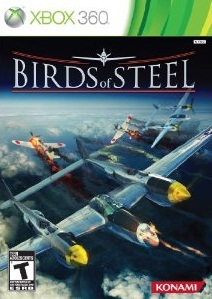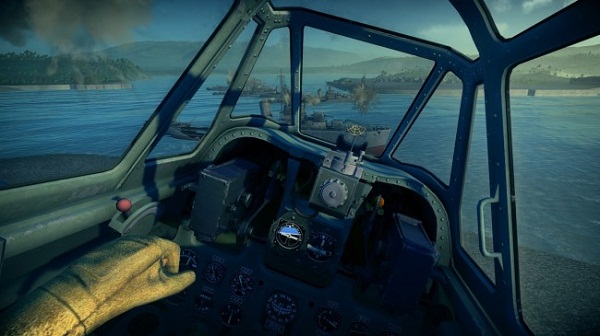A plethora of games use the theater of war as their centerpieces, relying solely on the battles fought by ground troops. With first-person shooters still on the rise thanks to Call of Duty, Battlefield, and Halo, it’s no wonder why the trend has continued for over the past decade. It’s rare then, when a developer decides to tell the story of conflict through navies or aerial forces. Konami and Gaijin Entertainment decided to take on that challenge by rolling the clock back to the 1940s with Birds of Steel, a WWII-era title that combines flight simulation and air combat.
Though the game’s selection of military craft ranges from various points of the war, Birds of Steel’s campaign focuses on a certain location: The Pacific Theater. Tutorials prior to U.S. involvement in the war get players assimilated, and then the game proper enters the conflict right at its beginning via the Japanese attack on Pearl Harbor. It then follows important battles of the war from 1941-1942, when the vast majority of clashes happened at sea and in the air. Though gamers will first play on the American side, Birds of Steel also offers a chance to play through the same time period as those on the opposite side of the conflict. The Japanese campaign shows the Axis powers’ moments of triumph that eventually wither and lead to the destruction of its aircraft carriers, signaling the beginning of island-hopping warfare.
The choice is certainly a strange departure from the norm, but it’s part of Birds of Steel’s appeal. Complete with newsreel clips of battles along with well-delivered monologues and music that ooze’s the time period, these single-player endeavors show that there are two sides to every conflict. Though not deep enough to prove incredibly moving, it still puts extra perspective on wars and those who fight in them.
Any game that has a heavy focus on controlling planes through the skies will have a difficult challenge ahead of it. Flight is not something easily mapped to a controller, and most players don’t like anything too complicated. Luckily, Gaijin made controlling these war birds easy with three different settings for the casual, experienced, and hardcore pilots. It makes me, someone who crashes a plane in seconds under extensive button layouts, look like a true ace with little to no frustration at all.
Having the controls down allows one to fully enjoy the best part of Birds of Steel: actually engaging in combat. From flanking enemy squadrons and picking them apart one by one, to launching torpedoes on aircraft carriers and dive-bombing towards battleships, it all feels immensely rewarding. Firing these weapons is a cinch, and finding a target won’t prove difficult thanks to the game’s lock-and-switch system. Though getting a proper dive or torpedo launch can cause some frustration, it’s all done in the pursuit of authenticity, and for that it can be forgiven.
Realistic aircraft damage authentically affects flight control, be it from a massive shell or a few machine gun rounds. A damaged wing causes the plane to drift in one direction and become harder to turn in the other. A stuck engine loses strength or dies, leaving me to fight for altitude or plummet toward the sea or a landing. Though intriguing at first, it quickly becomes apparent that there is no way to repair damage, leaving a pilot to suffer such wonky controls after every hit.
While the game’s single-player and co-op offerings are a pleasant treat, the competitive multiplayer is downright disappointing, limiting players to three gametypes, which are all small variations of one central mode. It doesn’t help that this central game type is flawed. Meant as a domination mode, the games only feature one capture point in the center of the map. The problem with this is that it takes approximately one to two minutes to fly from one’s spawn point to the capture point – too long to prevent an opponent’s victory.
Konami and Gaijin seemed to take a risk by trying their hands at a military game that’s not a first-person shooter, but the results were actually not as terrible as some would assume. An customizable combat system, a mission editor, and a leveling system make for an accessible and enjoyable title. Though nothing about the game may absolutely wow players like a AAA title, and the competitive multiplayer falls way short of expectations, Birds of Steel is still one of the best aerial combat simulations out there. Dog fight fans and history buffs should get their money’s worth with this title, while others are likely to find a nice, though possibly brief, break from all the running and gunning done by troops on the ground.




















